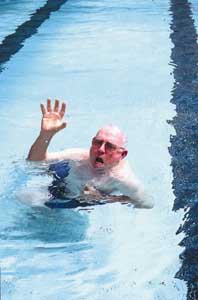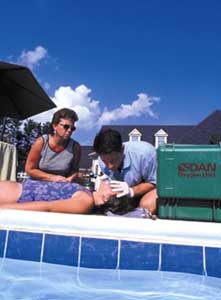|
Oxygen First Aid for
Aquatic Emergencies
 Every year more than
4,000 Americans die from drowning and many more suffer from near-drowning
events. Every year more than
4,000 Americans die from drowning and many more suffer from near-drowning
events.
According to the 1998 National Sporting Goods Association (NSGA) Annual
Sports Participation Survey, 58.2 million Americans participated more than
once in swimming during the year. The same study identified nearly 30
million people who participated in power boating, sailing, kayaking,
rafting or canoeing.
When swimmers and boaters have near-drowning accidents, water in their
lungs keeps their lungs from working properly and they don't get an
adequate amount of oxygen. This may cause secondary drowning; victims
appear to survive an incident only to die at home a few hours later.
Administering 100 percent oxygen first aid immediately after an accident
improves the victim's survival chances.
For nearly a decade, DAN has preached the benefits of providing oxygen
to injured scuba divers. During that time more than 80,000 people
worldwide have been trained in this first aid skill. In March of 1999, DAN
Services, Inc., a wholly owned for-profit subsidiary of Divers Alert
Network, launched the Oxygen First Aid for Aquatic Emergencies (Aquatics)
program. Its goal is to extend the life-saving skills of oxygen first aid
to people who live and play in and around water. Providing high
concentrations of oxygen to near-drowning victims in the first few minutes
after rescue can prevent serious or even fatal complications.
 Course Objective Course Objective
This course, Oxygen
First Aid for Aquatic Emergencies, or Aquatic Oxygen Provider, represents
training designed to educate the public to recognize possible aquatic
related injuries and to provide emergency oxygen first aid while
activating the local emergency medical services (EMS) and / or arranging
for evacuation to the nearest medical facility.
Recommended Minimum Hours of Training
Knowledge Development: The Oxygen First Aid for Aquatic Emergencies
Student Handbook and video are designed for student self-study. If an
Instructor elects to present the knowledge development section as a
lecture, it is strongly recommended that the video and training slides be
used to supplement the lecture.
Self-Study: 2 Hours
Lecture: 1 Hour
Skills Development: 3 Hours
|